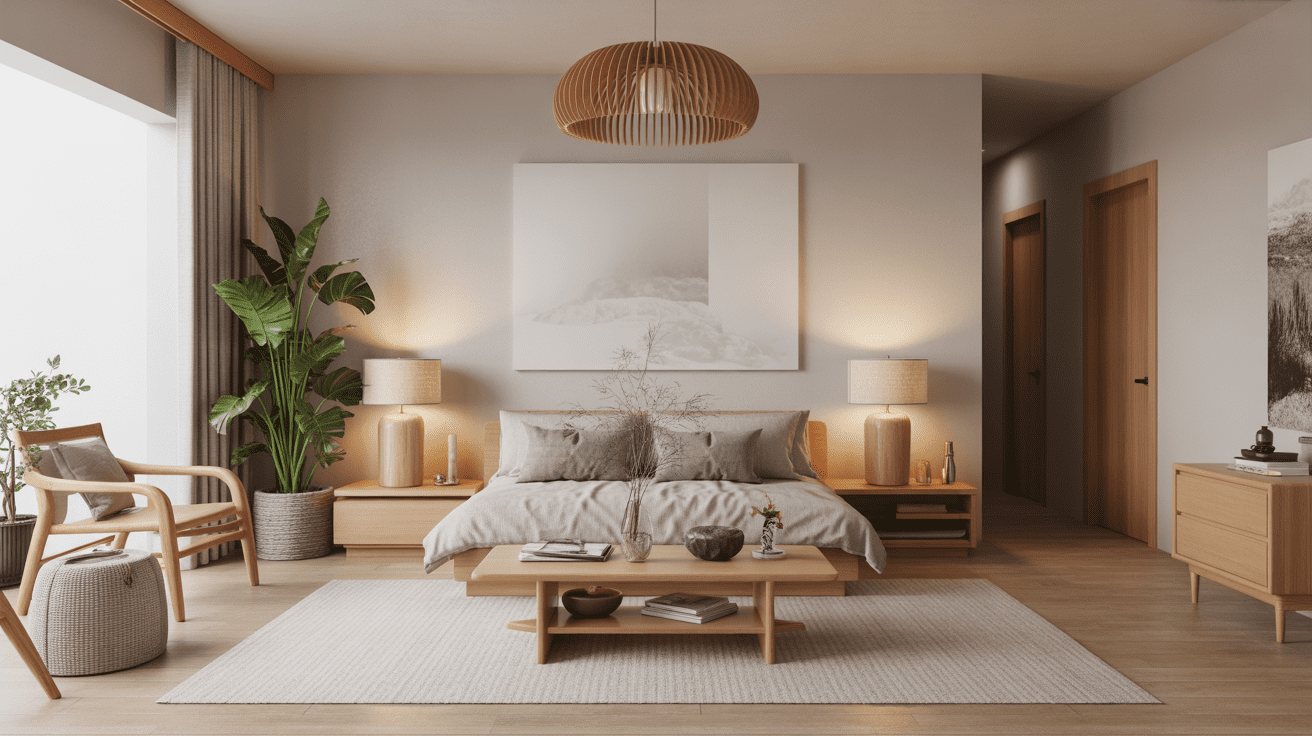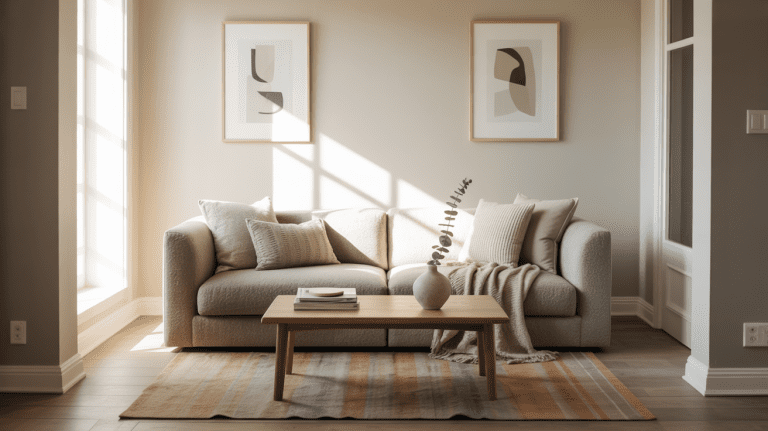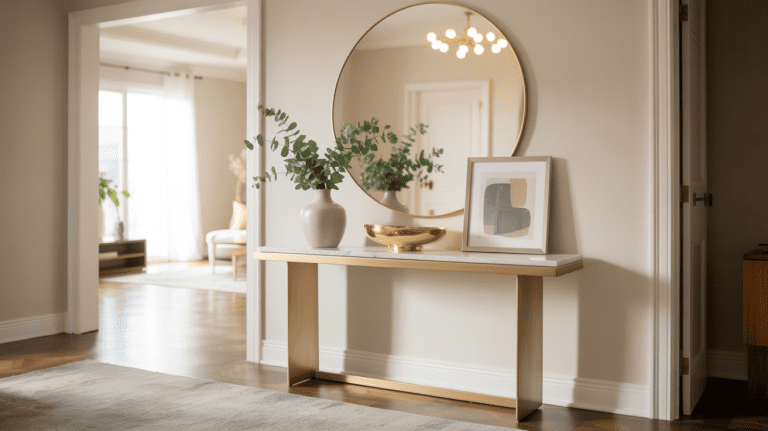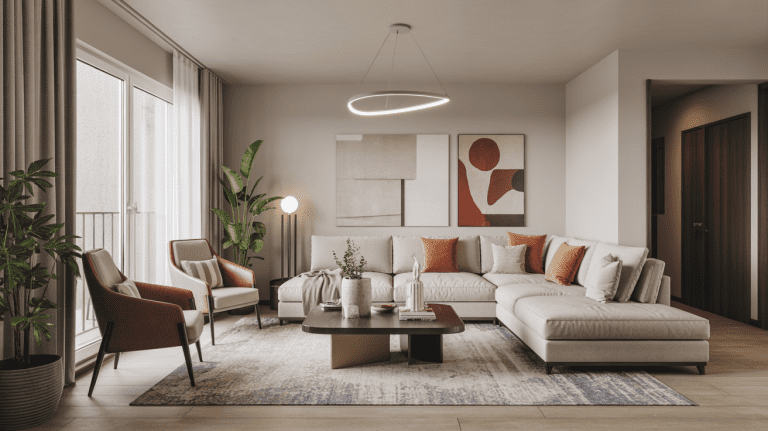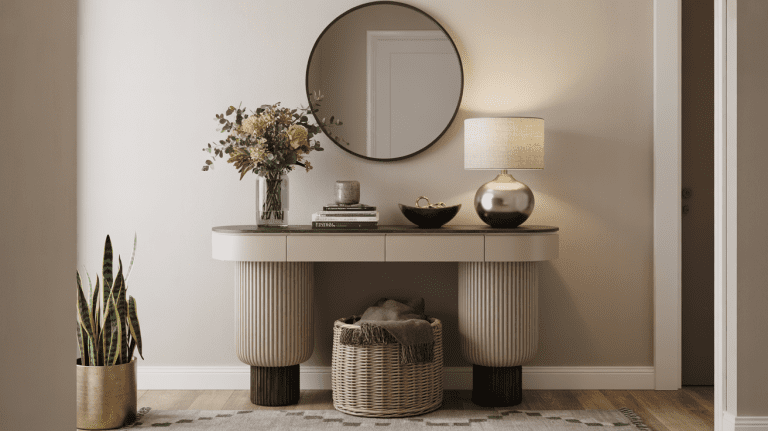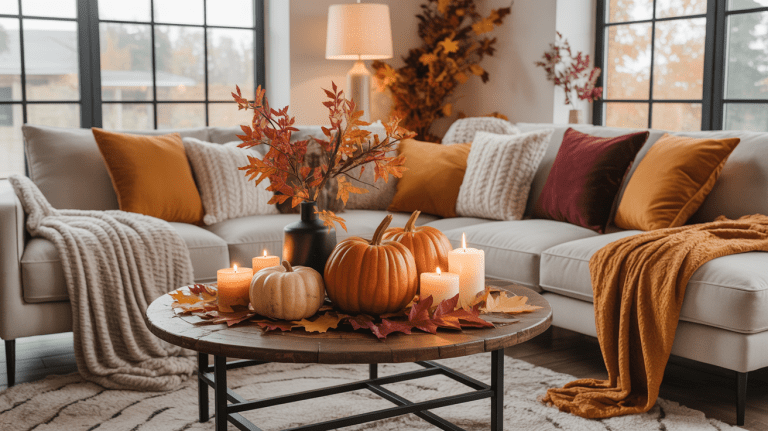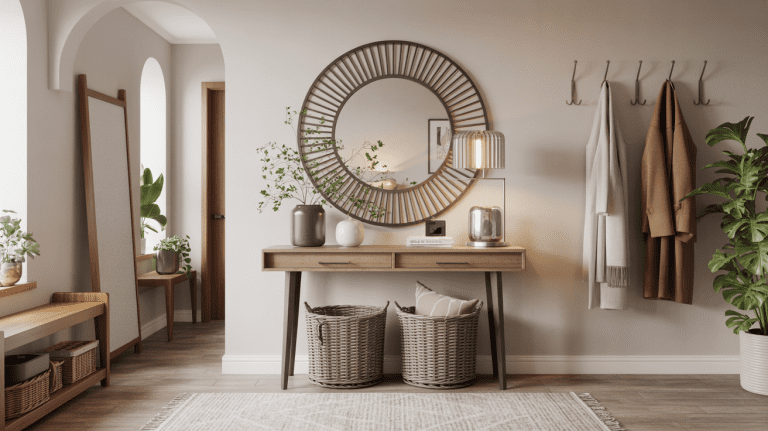7 Japandi Interior Ideas for a Minimalist and Elegant Home
Japandi interior design combines the simple elegance of Japanese style with the cozy warmth of Scandinavian decor. It focuses on creating calm, functional spaces that feel both minimal and inviting. This design trend has grown in popularity for its timeless look and practical approach to home interiors.
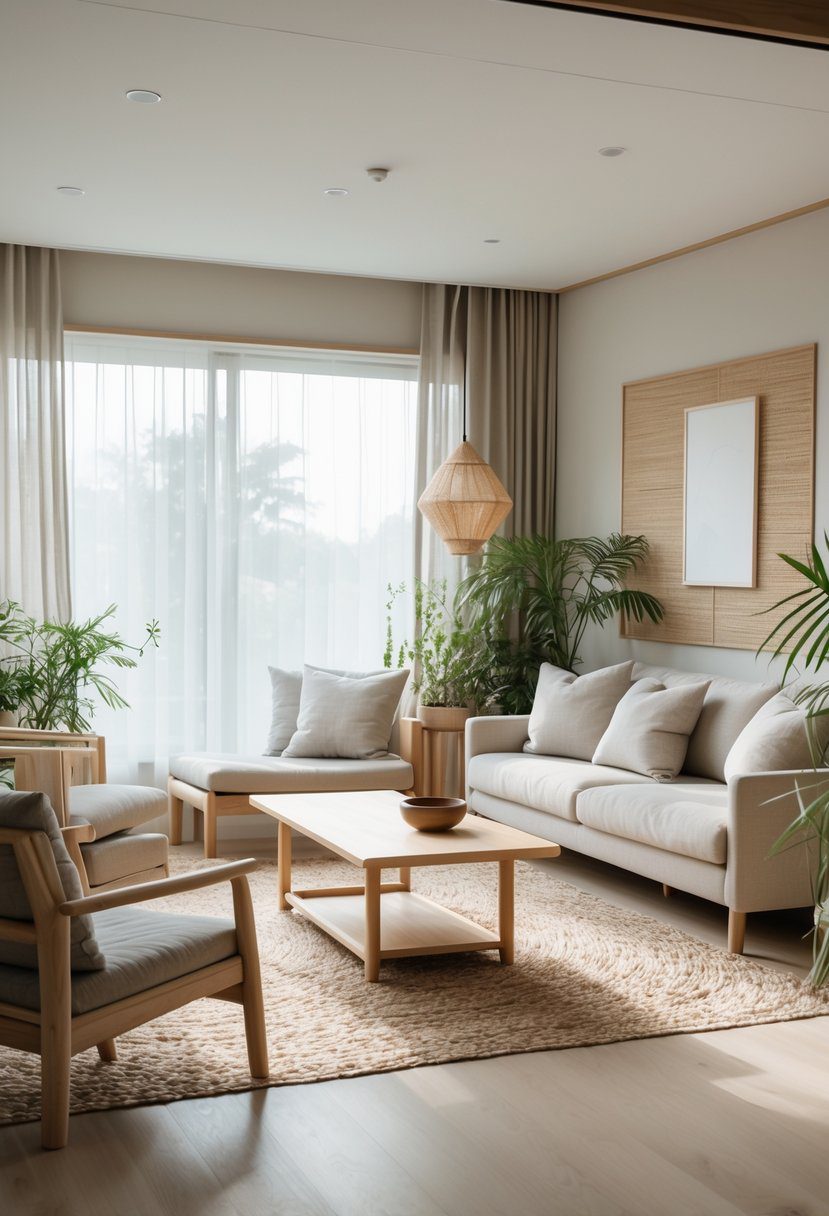
The key to Japandi is blending minimalism with comfort to make living spaces feel peaceful and natural. People who enjoy clean lines, natural materials, and soft color palettes often appreciate this style. It suits those looking to create a balanced environment that values simplicity without losing warmth. For more details, see the Japandi design principles at Bob Vila.
1) Neutral color palettes with soft beiges and greys
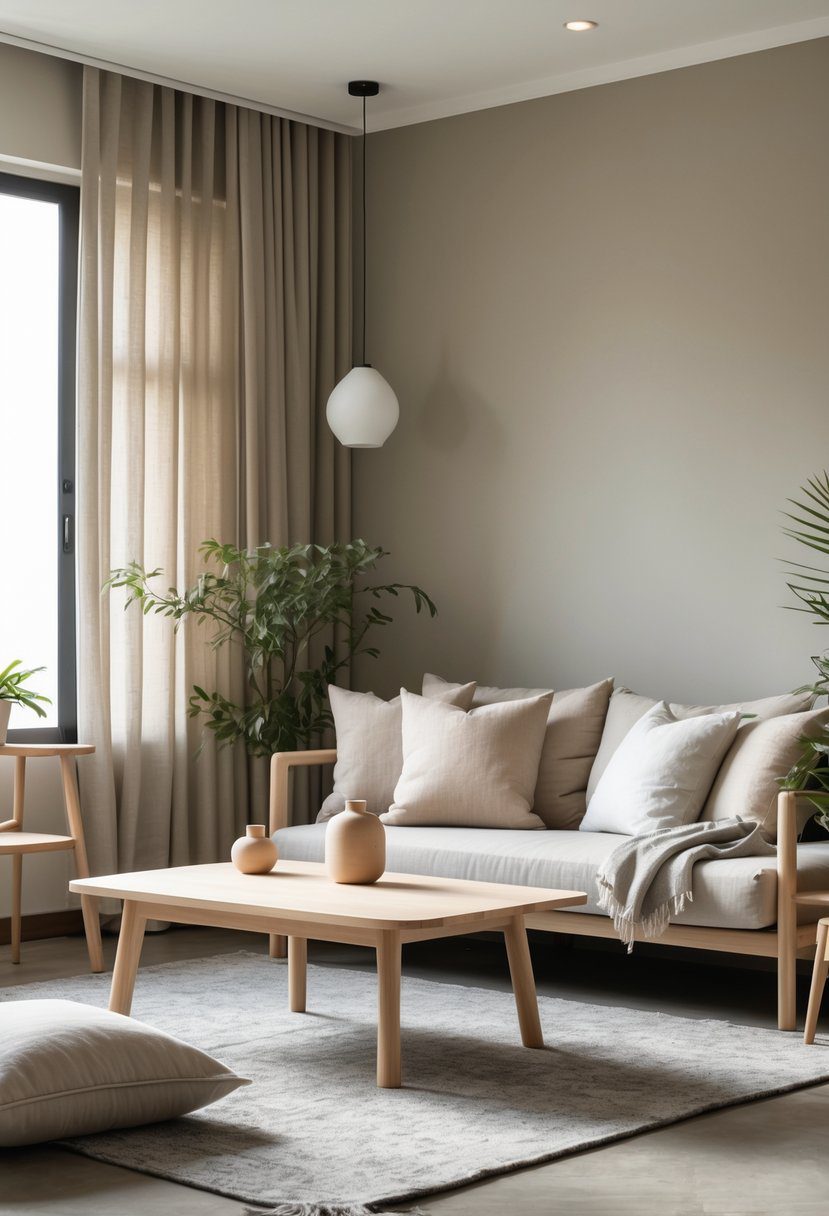
A key feature of Japandi interiors is the use of neutral colors like soft beiges and gentle greys. These shades create a calm and simple background that supports the minimalist style.
Soft beige adds warmth without overpowering the space. It brings a natural, earthy feel that pairs well with wood and natural materials.
Greys in Japandi design tend to be muted and light. They provide a cool balance to warmer tones and help maintain a clean, modern look.
Using these colors on walls and larger surfaces creates a serene atmosphere. It allows furniture and decor to stand out quietly.
For flexible design, combining soft whites, beiges, and greys offers depth but stays visually peaceful. This approach fits well in living rooms, bedrooms, and other spaces.
More details about this approach to color can be found in the guide to the Japandi color palette and expert-selected Japandi paint colors.
2) Natural materials like wood, bamboo, and rattan furniture
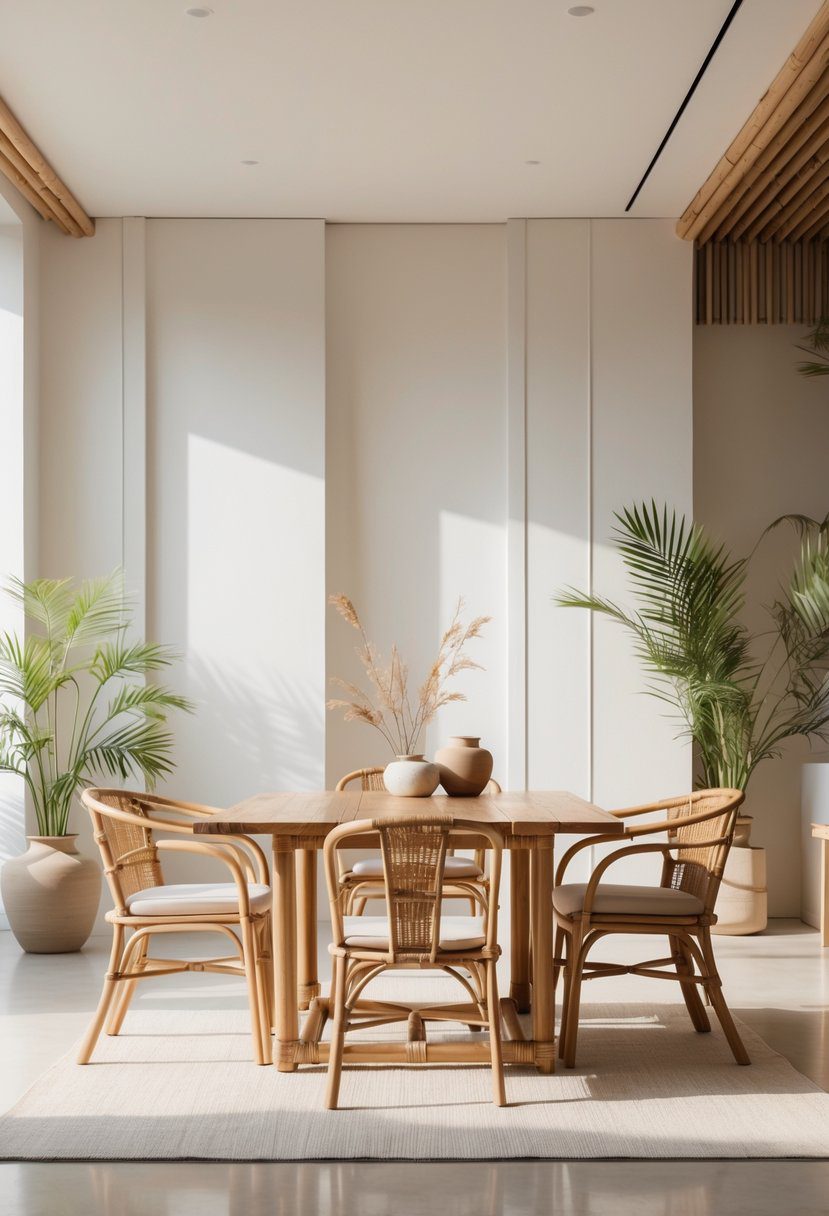
Japandi interiors often feature furniture made from natural materials like wood, bamboo, and rattan. These materials bring warmth and texture to a space. They also help create a calm and inviting atmosphere.
Wood is a key element in Japandi design. It adds a natural feel through its grain and tones. Bamboo is valued for its strength and eco-friendliness. It is used in furniture and window treatments to introduce a gentle, organic look.
Rattan furniture adds lightness and texture without feeling heavy. It complements the clean lines typical of Japandi style. Natural fibers like these help connect the indoors with nature, which is a core idea in Japandi living. Using wood, bamboo, and rattan makes the space feel balanced and grounded.
More details about these materials can be found in the article on Japandi furniture design.
3) Minimalist, functional furniture with clean lines
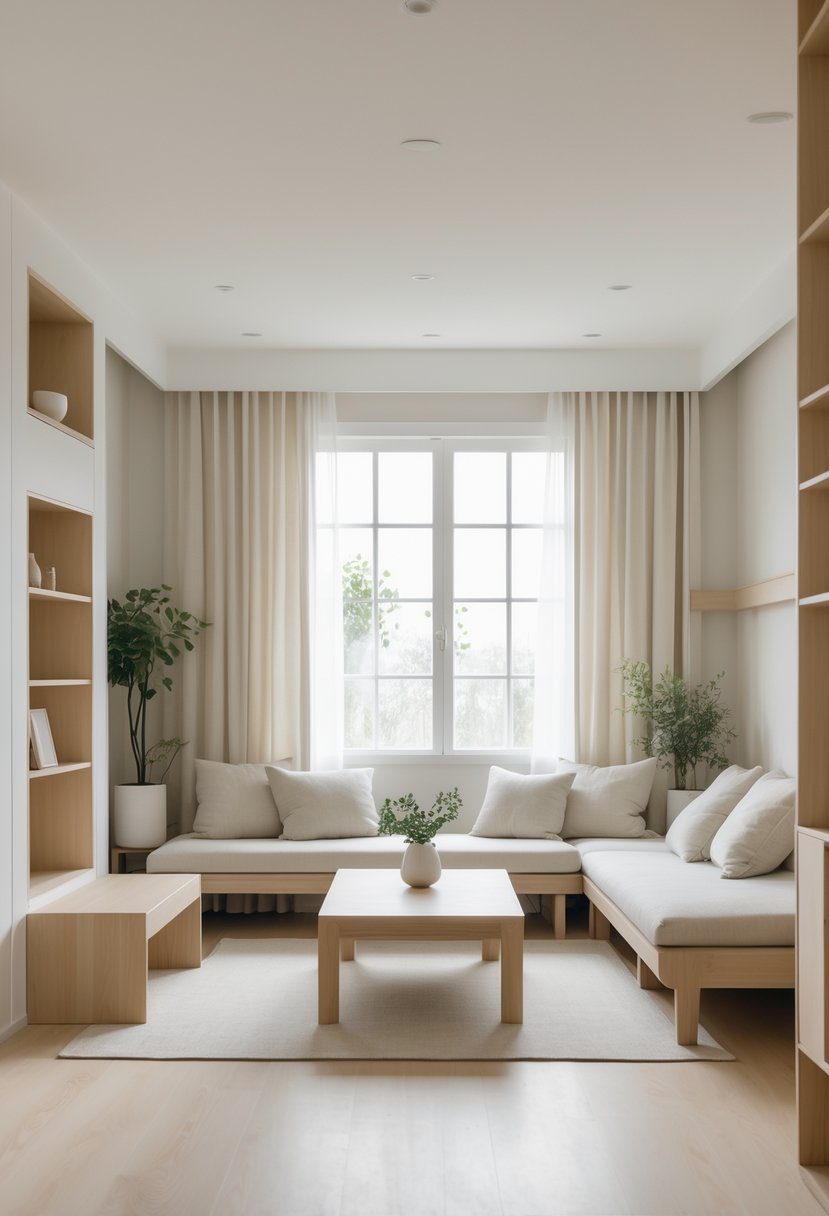
Japandi interiors focus on furniture that is simple and practical. Pieces usually have clean, straight lines with no extra decoration. This keeps the look neat and uncluttered.
The furniture often uses natural materials like wood. Low-profile sofas and wooden tables are common choices. These items balance functionality and style without drawing too much attention.
Storage solutions are important too. Shelving units and cabinets are designed to be both useful and visually calm. Open shelving or glass-front doors help keep the space organized while maintaining a light feel.
Choosing neutral tones for furniture helps create a peaceful atmosphere. Soft colors like beige, gray, or muted greens work well. This allows the natural textures and materials to stand out without overwhelming the room.
To see examples of key furniture pieces for a minimalist Japandi interior, visit this guide on Japandi Furniture: Key Pieces for Your Minimalist Interiors.
4) Incorporation of greenery and indoor plants
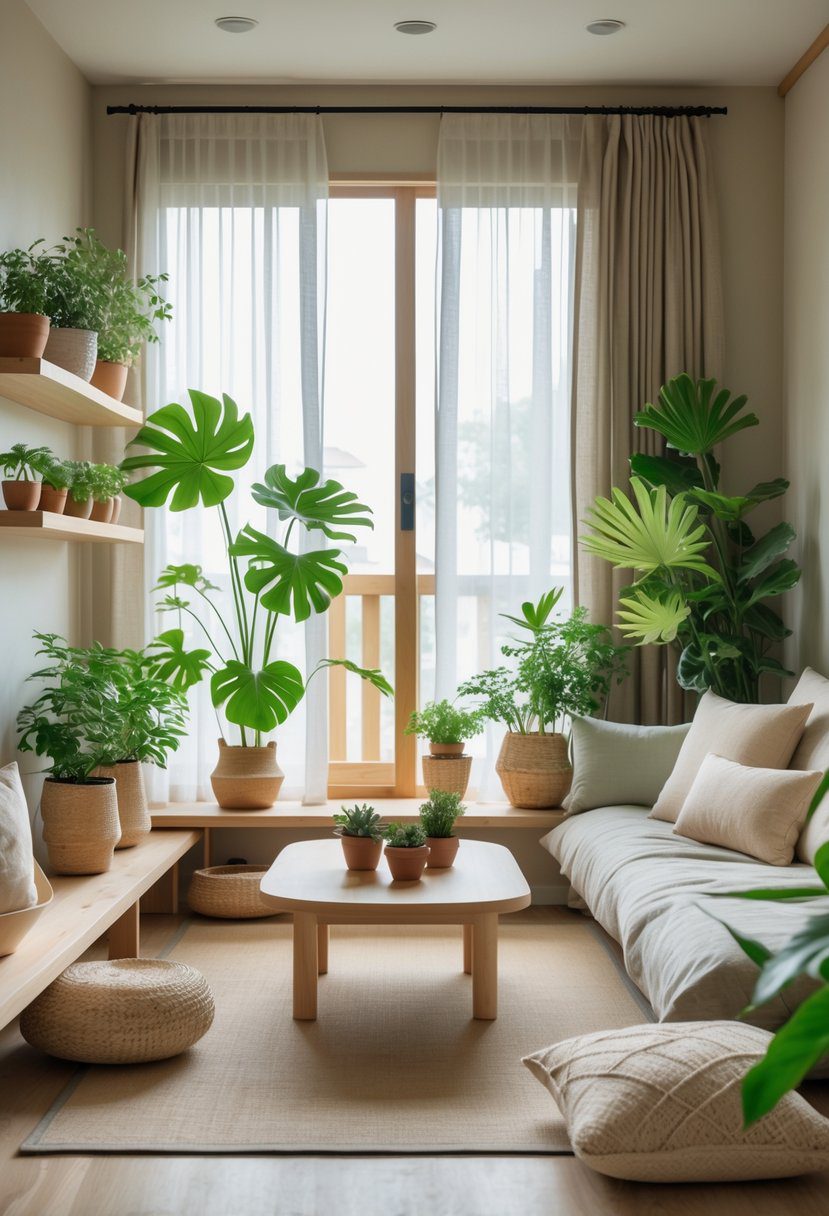
Greenery plays an important role in Japandi interior design. It brings a natural feel that fits well with the blend of Japanese and Scandinavian styles. Plants add life to the space without overwhelming the simple, clean lines.
Common plants in Japandi spaces include bonsai trees, snake plants, and fiddle leaf figs. These plants are chosen for their shapes and calming presence. They help create a peaceful and balanced environment.
Indoor plants also improve air quality. They reduce pollutants and contribute to a healthier home. This adds to the overall sense of well-being Japandi design aims to achieve.
Planters are simple and made from natural materials like clay or stone. They match the neutral tones of the style. Using varying plant sizes gives the room depth and softness.
For those interested in details, more about how Japandi uses indoor greenery is available on Japandi Indoor Plants Selection and Exploring How Japandi Incorporates Indoor Greenery.
5) Soft, textured textiles like linen and wool
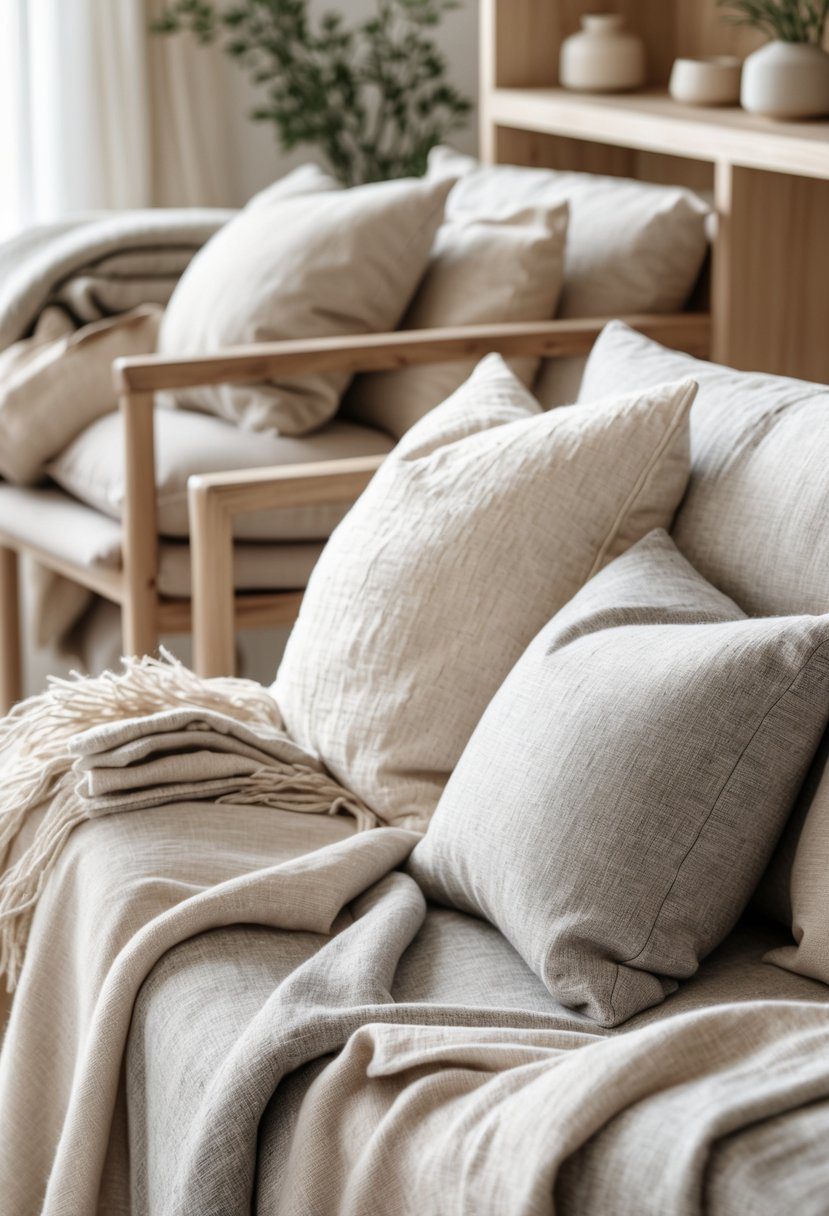
Textiles play an important role in Japandi interiors by adding warmth and comfort. Linen and wool are common choices because they bring natural texture without being too bold.
These materials soften the minimalist look and make the space feel inviting. Wool throws and linen cushions are often used to add subtle layers of texture.
Using textiles like these helps balance the clean lines and natural materials found in Japandi design. They create a cozy atmosphere while keeping things simple and functional. For more details about textiles in Japandi, see Japandi Interior Style — myStofa.
6) Low-profile, handcrafted wooden joinery
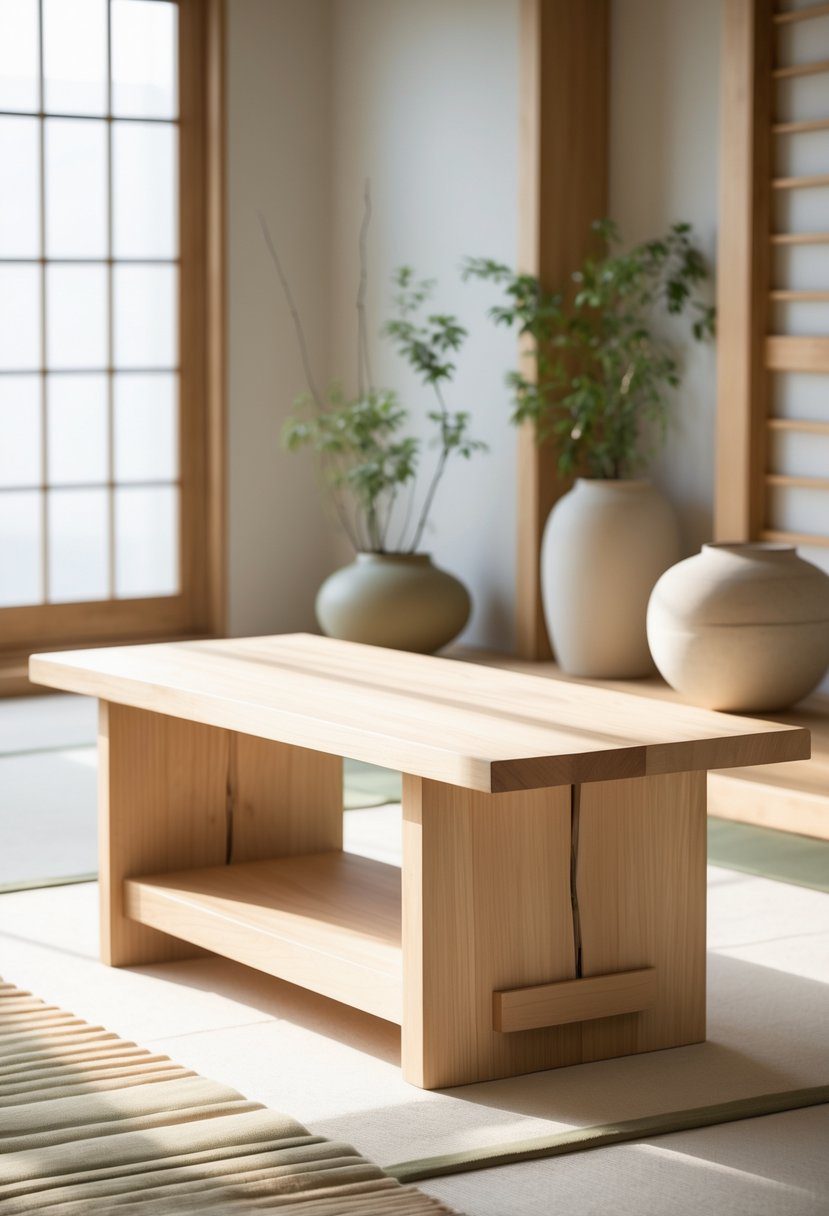
Japandi interior design favors low-profile furniture that stays close to the ground. This choice helps keep spaces open and uncluttered, supporting a calm atmosphere.
Handcrafted wooden joinery is a key feature. These carefully made joints show skill and durability without using nails or screws. The craftsmanship highlights the beauty of natural wood.
Using well-crafted wooden pieces adds warmth and texture. It also reflects Japandi’s focus on quality and sustainability, making furniture that lasts longer and feels connected to the space. See more about traditional Japanese joinery and wood species in Japandi design.
7) Blending Scandinavian coziness with Japanese simplicity
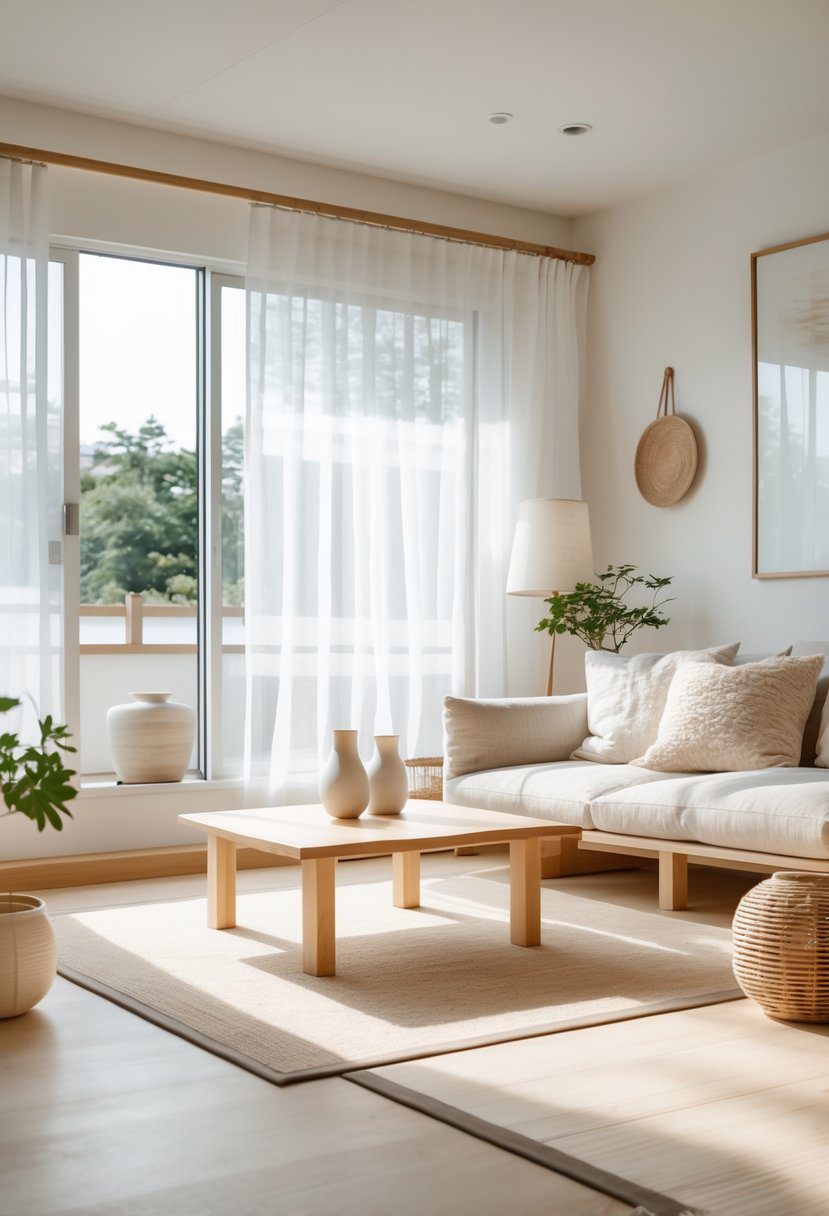
Japandi design merges the warmth of Scandinavian coziness with the clean, minimalist simplicity of Japanese style. This blend creates living spaces that feel both inviting and peaceful.
Natural materials like wood and linen are common. They add texture without cluttering the space. Neutral colors support a calm and balanced atmosphere.
The style values functionality and beauty equally. Every item has a purpose, keeping the space uncluttered yet comfortable. Soft lighting and simple forms enhance the soothing effect.
This approach reflects respect for nature and quality craftsmanship. By combining these traditions, Japandi achieves a stylish and serene interior that meets modern needs. Learn more about this blend of Scandinavian and Japanese design here.
Japandi Design Philosophy
Japandi design focuses on creating spaces that balance simplicity with comfort. It values clean lines and open areas while making the home feel inviting and lived-in. The choice of colors and materials plays a key role in achieving this harmony.
Balancing Minimalism and Warmth
At the heart of Japandi philosophy is the fusion of Japanese minimalism and Scandinavian warmth. It avoids clutter by using simple, clean shapes and functional furniture. However, it does not feel cold or empty.
Soft textiles, cozy throws, and natural wood bring warmth and comfort. This combination creates a calm but welcoming atmosphere. The style emphasizes quality over quantity, encouraging intentional living. Every item has a purpose and a place, promoting balance between form and function.
Color Palette and Materials
Japandi uses a calm color palette mostly made up of neutral tones. Shades like beige, soft gray, and muted greens are common. These colors create a peaceful background that highlights natural elements.
Materials are mostly natural and sustainable. Wood, bamboo, stone, and linen are often featured. Such materials add texture and a sense of connection to nature. The mix of smooth and rough finishes adds depth without overwhelming the space.
Together, the colors and materials support a serene, uncluttered look that feels grounded and soothing. This careful selection helps Japandi spaces feel timeless rather than trendy. For a detailed look, read more about Japandi’s philosophy and key design elements.
Incorporating Japandi in Modern Spaces
Japandi style brings together clean lines, natural materials, and thoughtful details to create calm and inviting modern interiors. It focuses on choices that balance function with beauty and respects the environment through material selection and design.
Functional Furniture Choices
Furniture in Japandi interiors is simple yet purposeful. Pieces often feature low profiles, clean silhouettes, and smooth surfaces without unnecessary decoration. This helps maintain an open and airy feel.
Materials like wood and bamboo are common, highlighting natural textures. Multi-use furniture, such as storage benches or extendable tables, supports compact living while keeping the space tidy.
Comfort is key. Soft cushions and ergonomic designs add warmth without clutter. The goal is to blend utility with aesthetics, so every item serves a clear purpose.
Sustainability and Eco-Conscious Elements
Sustainability is essential in Japandi design. It emphasizes using natural, renewable materials such as solid wood, bamboo, stone, and organic textiles. These materials age gracefully, adding character over time.
Choosing high-quality and durable items reduces waste. Japandi spaces avoid fast furniture trends, focusing on long-lasting pieces.
Incorporating plants enhances air quality and connects interiors with nature. Energy-efficient lighting and recycled decor also support eco-friendly living.
For more on how sustainability fits Japandi interiors, see this guide on Japandi design principles.
Frequently Asked Questions
Japandi style focuses on blending simplicity with warmth using specific colors, materials, and furniture choices. It combines natural elements with clear, functional design to create calm and inviting spaces.
What are the key elements of Japandi style in home decor?
Japandi uses neutral color palettes with soft beiges and greys. Furniture is minimalist and functional with clean lines. Natural materials like wood and bamboo are common, alongside soft textiles such as linen and wool.
How can I incorporate minimalism into a Japandi-inspired space?
Keep spaces clutter-free and choose furniture with simple shapes. Use only essential items that have clear function. Focus on open areas that allow light and air to flow freely.
What color palettes are typically used in Japandi interiors?
Japandi interiors often use neutral tones, including soft beiges, greys, and muted earth colors. These colors create a calm and natural feeling in the room.
What types of materials should be used to achieve a Japandi aesthetic?
Natural materials like wood, bamboo, rattan, and textiles such as linen and wool are essential. These materials add texture while keeping the space connected to nature.
How does one blend Japanese and Scandinavian design principles effectively?
The key is balancing Japanese minimalism and Scandinavian warmth. Combine clean lines and minimal clutter with cozy textiles and functional furniture to make a space that feels both simple and inviting.
What are the best ways to introduce natural elements in a Japandi style room?
Incorporate greenery through indoor plants. Use natural wood furniture and decor made from bamboo or rattan. Soft textiles with natural fibers can also add warmth and texture while keeping the natural theme.
For more details, see the guide on Japandi Interior Design.

